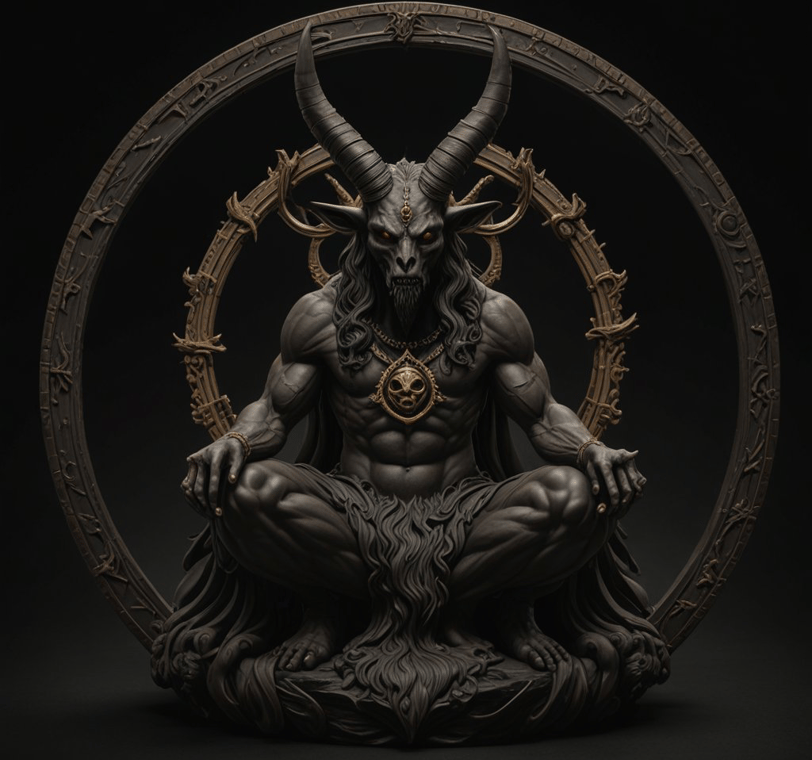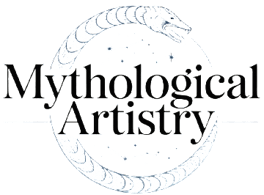Where Myth Meets Modern Art
Baphomet: From Templar Myth to Esoteric Icon
Discover the mysterious journey of Baphomet—its medieval origins, reinterpretation by Éliphas Lévi, and transformation into a modern symbol of balance, duality, and inner transformation. Uncover the myth, history, and deeper meaning behind this enigmatic figure.
6/8/20255 min read


Introduction
Baphomet is a figure shrouded in mystery, with roots stretching back to medieval tales of heresy linked to the Knights Templar and evolving over time into a symbol of balance and esoteric knowledge. Its first documented appearance is in the Inquisition trials against the Knights Templar in the 14th century, where it was described as an idol worshipped in secret. However, the truthfulness of these accusations has been widely disputed: most historians agree that these confessions were the result of torture and the political machinations of those seeking to destroy the Templars and seize their wealth. In the 19th century, Baphomet was reimagined by the French occultist Éliphas Lévi, who gave it a new iconography and deep symbolic meaning, representing the harmony of opposites: light and darkness, masculine and feminine, spirit and matter. From a medieval accusation, Baphomet thus became a complex, multifaceted archetype that continues to provoke questions and reflections on human dualities and the nature of the sacred and profane. Today, its symbolism permeates art, esoteric philosophy, and popular culture, inviting us to explore the hidden meaning behind the goat-headed figure and its many interpretations.
1. Medieval Origins and Templar Accusations
The name “Baphomet” first appeared in the records of the trials against the Knights Templar, which began in 1307 in France by order of Philip IV. According to confessions extracted under torture, Baphomet was an idol worshipped in secret, sometimes described as a severed head or a figure with monstrous features. However, modern historians view these testimonies as unreliable, the product of an Inquisition determined to prove guilt at any cost. In some texts from the era, “Baphomet” seems to derive from a medieval distortion of “Mahomet” (Muhammad), likely intended to associate the Templars with foreign cults and heretical practices. In this sense, the legend of Baphomet was less about a real figure and more a tool of propaganda to justify the suppression of the Templars. There is no archaeological or historical evidence of such an idol in Templar rituals, but the legend persisted for centuries, fueling myths of secret knowledge and forbidden worship.
2. Nineteenth-Century Reinterpretation and the Symbolism of Éliphas Lévi
In the 19th century, Baphomet found new life through the work of French occultist Éliphas Lévi, who transformed it from a mere medieval accusation into a universal symbol of balance. Lévi depicted Baphomet as an androgynous figure with human and goat features, wings, a torch between the horns, and a caduceus at the center of its body. For Lévi, Baphomet was not a demon but a profound symbol that embodied the mysteries of the universe and the union of opposites: masculine and feminine, light and shadow, spirit and matter. The words “Solve” and “Coagula” etched on the arms represent the alchemical processes of dissolution and reconstitution. Through this iconography, Lévi encouraged the viewer to see Baphomet as an archetype of the inner journey—an invitation to move beyond apparent dualities to discover the hidden unity of all things. Far from a malevolent figure, Baphomet became a powerful emblem of esoteric wisdom, cosmic balance, and the human capacity for transformation.
3. Guaita’s Sigil and Its Modern Spread
In 1897, esoteric scholar Stanislas de Guaita created the “Sigil of Baphomet,” a goat’s head inscribed in an inverted pentagram surrounded by Hebrew letters spelling “Leviathan.” This sigil was later adopted by modern esoteric circles and certain contemporary organizations as a symbol of autonomy and personal freedom. The inverted pentagram in magical tradition represents the precedence of matter over spirit and an acceptance of the earthly aspect of the human experience. The sigil has been featured in various artistic and cultural contexts to evoke inner strength and creative power, becoming a symbol of personal exploration and self-affirmation beyond traditional social and religious conventions.
4. Symbolic and Mythological Interpretations
Baphomet’s figure is rich with alchemical and mythological symbolism. Its goat-like features recall ancient deities such as Pan in Greek mythology and Banebdjedet in Egyptian lore, both linked to nature’s power and fertility. Baphomet is often interpreted as a representation of universal balance, the union of complementary opposites that generates harmony and transformation. In esoteric philosophy, Baphomet’s androgyny symbolizes the principle of wholeness—an integrated being that transcends separation and the illusion of duality. The caduceus and the lit torch are references to hidden knowledge and the light of awareness that emerges from shadow. In many spiritual traditions, Baphomet is not seen as an evil figure but as a guide to inner illumination and the discovery of one’s full potential.
5. Baphomet in Contemporary Culture
Today, Baphomet’s image is ubiquitous in artistic and popular culture. Its visage appears in monumental sculptures, like the 2015 statue in America that was presented as a symbol of pluralism and freedom of expression. It also features in films, comics, and video games, where it represents mystery and the search for truths beyond conventional dogma. In music and fashion, Baphomet is often used as an emblem of rebellion and authenticity, a sign of inner power challenging limitations. Beyond its aesthetic use, many artists and philosophers see Baphomet as an invitation to explore the hidden aspects of the self and integrate them into a journey of personal growth. Far from being a mere controversial symbol, Baphomet continues to inspire deep reflections on duality, creative energy, and the essential nature of the human experience.
6. Comparative Symbolism: Baphomet’s Gestures and Christ’s Iconography
A fascinating comparison emerges when examining the hand gestures and symbols of Baphomet alongside those used in traditional depictions of Jesus. In Éliphas Lévi’s portrayal of Baphomet, the right hand is raised with two fingers extended (index and middle) while the left hand mirrors this gesture but points downward—embodying the Hermetic principle “as above, so below.” This hand position represents the harmony of cosmic dualities, ritual balance, and the blending of spiritual and material realms.
Similarly, in Byzantine and Orthodox Christian iconography, Jesus is often shown with his right hand raised in a gesture of blessing. This arrangement of the fingers forms the Greek monogram IC XC, an abbreviation of “Jesus Christ.” The thumb and ring finger touch to symbolize the Incarnation—Christ’s dual nature as both divine and human—while the three extended fingers represent the Holy Trinity. In some traditions, the open hand with five fingers also recalls Christ’s five wounds, adding a layer of sacrificial symbolism.
From an alchemical perspective, both gestures carry profound significance. Baphomet’s dual gesture aligns with alchemical processes known as “Solve et Coagula”—the dissolution and recombination that enable spiritual transformation. The mirrored hand positions represent the cosmic axis: light descending into matter and spirit ascending into awareness.
Christ’s gesture, meanwhile, also has alchemical resonance. The IC XC sign functions as both a visual invocation and a symbolic merging of opposites—the divine and human—echoing the alchemical ideal of coniunctio oppositorum (union of opposites). In this sense, it mirrors the transformational work embodied by Baphomet.
Furthermore, Baphomet’s caduceus—a staff entwined with two serpents—symbolizes duality and unity, resonating with alchemical symbols of balance and regeneration. In Christian iconography, the globus cruciger (an orb surmounted by a cross) held by Jesus or Christian rulers symbolizes dominion over the earthly and spiritual realms. In alchemical symbolism, the globus cruciger also signifies antimony, an agent of purification and transformation.
Through these parallels, it becomes clear that both Baphomet and Christ’s iconography use hand gestures and symbolic elements to express universal truths: the balance of dualities, the power of spiritual union, and the potential for personal transformation. Though they belong to different cultural and religious contexts, they both draw upon ancient traditions of mystical symbolism, inviting contemplation of the divine and the mystery of human existence.
Conclusion
The story of Baphomet reminds us that symbols are living, ever-changing forces. From medieval accusations to its modern role as an emblem of balance and wisdom, Baphomet traverses centuries and cultures as an archetype of synthesis and inner exploration. It invites us to look beyond appearances, to seek the union of light and shadow, and to recognize the transformative power that comes from embracing the totality of who we are.
Artistry
Explore unique mythological and esoteric artworks today.
Contact
© 2025. All rights reserved.


Legal Notes
